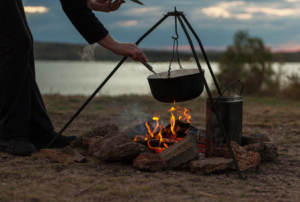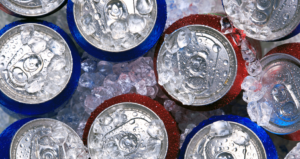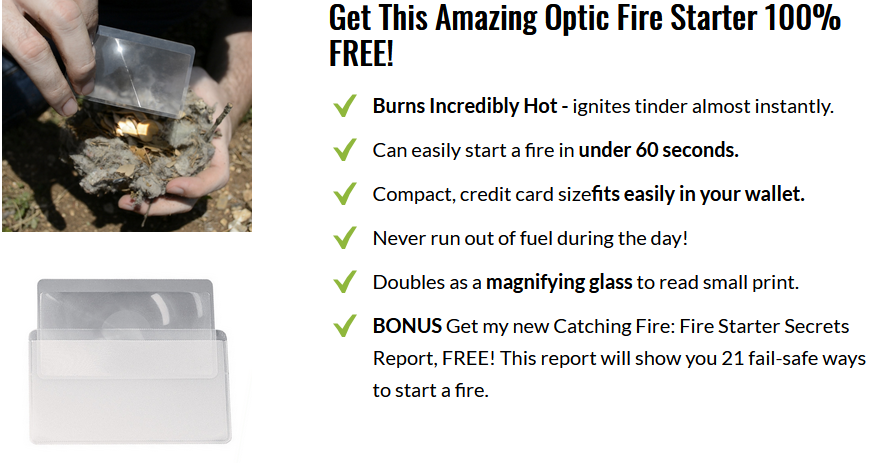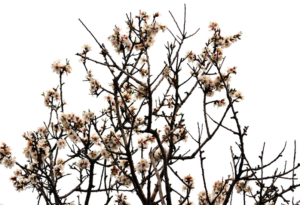
Ever since the ages of the evolutionary history of man, fire has always been an integral part of human life. Understanding a few basics, such as making fire devoid of a lighter, is essential to every human being. It is also vital for people to know how to make a fire according to the environs, paying attention to aspects such as weather.
Other crucial points of understanding as far as fire is concerned are making a campfire for survival, the most suitable wood for use, starting and maintaining a campfire, making a campfire with little or no smoke, and keeping a campfire disguised more. This article will give a thorough overview of all details entailing a campfire.
Unique and Reliable Ways of Starting a Campfire for Survival

Keeping warm in the wild is vital. As such, starting a campfire is an essential skill that everyone should have. In addition to keeping you warm, a campfire will also protect animals, provide light, and help prepare food.
The aforementioned are important considerations whenever in a survival situation. For absolute newbies in outdoor camping, learning how to light a fire may be challenging. This thorough guide will teach how to start a campfire using the best survival techniques.
1. Using An Orange

Citrus oils are combustible. Therefore, getting some sparks into an orange can start a fire. To actualize this trick, one will need to make a hole at the top of an orange and scoop some flesh, and allow it to dry for some time.
After these procedures, place a hard stone in the orange and put a stick or a knife on the piece of stone. Speedily rub the tool against the stone until the stone sparks. This way, you will get a satisfactory starter for your campfire.
2. Using Beverage Cans

Aluminum reflects sunlight, and if concentrated on one spot for long enough, sunlight can start a fire. To reflect enough sunlight for a fire, an aluminum surface has to be tremendously shiny.
The best way to achieve this shiny surface would be to use a bar of chocolate, rub a piece of chocolate on a beverage can until you have achieved a bright shine, then set the can to reflect sunlight on your kindling material.
After this procedure, you should see some smoke within two minutes or so.
3. Using Potato Chips

Chips do not impulsively explode. However, they are highly combustible. In instances where you have difficulties lighting up your fire, and you have matches or alternative means of sparking a fire, and you can find no kindling material, you can place a few packets of chips under your wood.

Chips will catch fire quickly since they are covered in layers of fat and oil, which burn pretty well. Therefore, if you place you’re your spark well, you should get your fire effectively started.
4. Using A Battery

Primarily, fire is energy, and a battery stores quite a bit of energy. Therefore, the trick here is getting energy out of a battery. With a 9-volt battery, some steel wool, and a cloth, you can effectively make a flame enough to start a campfire.
Wet the center of the cloth, taking care to leave the outsides dry. Using the damp section of the cloth, grip the steel wool and place it on both contacts of the battery. You will spontaneously see sparks, enough to start your campfire.
5. Using Ice
On a bright sunny day, even ice can start afire. You will require a large, thin slice of ice to work out this hack. The ice works as a magnifying glass. Therefore, you will need to place it at an angle that will put a beam of sunlight on your kindling material.

With reasonably pure ice, you will concentrate so much heat on your kindling, and the outcome is almost spontaneous.
6. Using The Hand Drill
This is the most ancient and difficult method of making a survival campfire. The first step in this unique method of starting a fire is making a tinder nest.
The tinder nest is used to turn the ember that is created into a flame, and you can make a tinder nest using any dry material such a grass, leaves, or back. After preparing the tinder nest:
-
Cut a v-shaped notch into your fireboard and a small depression next to the notch.
-
Place your tinder nest under the notch.
-
Maintaining pressure on your spindle, spin it inside the depression.
-
Keep rolling it between your hands until an ember form on the fireboard.
-
Using balloons and condoms
By filling a condom or a balloon with water, it becomes a fire-creating lens. Fill the balloon or condom with water, making it as spherical as can be practical.
Please do not make the inflated material too big since it will deform the focal point of sunlight. Squeeze the water-filled balloon to form a shape that gives a sharp circle of light. Squeeze the condom in the middle to make two smaller lenses.
The aforementioned materials have a shorter focal length compared to a conventional lens. Hold them at a distance of 1-2 inches from your tinder and get an ember to start your campfire.
7. Using The Bow Drill
This is possibly the most reliable frictional method since it isis easier to maintain the speed and pressure required to make enough friction for starting a fire. Apart from a spindle and a fireboard, you will need to have a bow as well as a socket.
Create a socket that you will use to apply pressure on the other end of the spindle as you rotate it usi8ng the bow. The socket can be made from a stone or a piece of wood.

If you opt to use a piece of wood, find harder wood than that of a spindle. Preferably, use wood with oil and sap since it will create a lubricant between the spindle and the socket.
Then make a bow the length of your arm. Choose a flexible piece of wood, slightly curved. You can use anything for the bow’s string, such as a piece of rope, a shoelace, a strip of rawhide, or anything that might be around. Be sure to select something unbreakable. String up your bow, and it will be ready.
To prepare your fireboard, you will cut a v-shaped notch and make a depression next to the notch. Place your tinder below the notch.
String up your spindle by catching it in a loop of the bowstring. Place an end of the spindle in the fireboard and apply pressure on the next using your socket.
Using the just-made bow, start sawing to and fro; the rotation of the spindle should be quick. Continue sawing until ember forms. Drop the formed ember into the tinder nest and blow it gently to make a fire.
8. Flint And Steel
This method is an ideal standby fire starter since your matches can become wet therefore becoming useless. However, by putting steel to a significant piece of steel, you can manage to make a fire.
In the event that you do not this set of flint and steel, you can improvise it from quartzite and the steel blade of a pocket knife. You will also require a char cloth that has been converted into charcoal since it easily catches a spark and continues smoldering it without exploding.
In the event of the absence of char cloth, you can use either a piece of fungus or birch.
Hold the piece of rock between the thumb and your forefinger, ensuring that there is a 2-3 inches edge hanging out.
Hold the char between your thumb and the flint. Using the back of your knife blade, strike the steel against the flint a few times. Sparks from the still will fall on the char cloth and cause a glow. Form your char cloth into a tinder nest and blow it to start your campfire.
9. Using The Conventional Lenses Method
To start a fire, you will need to focus sunlight on a particular spot for a long time. You can use a magnifying glass, binocular lenses, or eyeglasses.
Adding some water to the lens will intensify your beam. Set the lens towards the sun at an angle such that the beam will focus on the smallest area possible. Put your tinder under the beam spot to start your fire.
Key Materials Required To Make A Campfire:
Tinder

These are small and lightweight materials that help in the basic making of fire. There are various forms of tinder, including cardboard strips, wood shavings, sawdust, wax, waded paper, and more.
Campers are advised to carry their homemade tinder since it might be challenging to find reliable tinder in wet surroundings.

Kindling

This refers to the next layer in the fire-making process. Kindling consists of medium-sized materials that light spontaneously the moment they are in contact with tinder.
Such materials include small sticks and twigs or large pieces of tinder that qualify to be used as kindling.
The most suitable twigs should ideally be in the range of an eighth to a half-inch in diameter since anything more significant than that might be challenging to light from tinder. Be sure to pick this item dry for aster lighting.
Wood Logs

These are vital since they will keep the fire burning for long, and they primarily give life to your fire. Campfire is not likely to burn so brightly when there is no reliable fuelwood.
As such, the fire will not keep you warm to the satisfaction or for a long time. The sizes of fuelwood can be in the range of 1 to 5 inches in diameter.
However, they do not have to be irrationally huge but significant enough to keep the fire alive. Large logs may take long to catch fire, which will leave you cold for longer.

Similar to all other materials in the process of fire building, fuelwood should be dry. You may use your survival axe or a sharp knife to size your fuelwood.
It is essential to know that various kinds of wood burn at varying rates. For instance, hardwood like maple or oak takes longer to catch fire but burns for longer. For softwood, like cedarwood, burns quicker with crackling sounds.
Choosing A Site For Your Fire

In a situation in which survival is pivotal, it I not always practical to tell how safe your area is. However, failure to start a fire in the right place might land you in trouble. There are a few essential considerations to make before starting a fire.
Ensure that your fire site is free from any trees, bushes, or plants so that you do not set them ablaze. Preferably, your spot of choice should at least be six feet away from any external or plant material.
It would be best to start your fire on bare ground and not on a grassy patch or grass. If it is not practical to find bare ground, you can achieve it by removing vegetation and digging up to form a bare spot.
Ensure that there is no dry material around, such as branches and barks, since they can easily catch fire. As a measure of keeping your fire contained, it is advisable to make a stone fire ring. This will also be helpful in marking out the area on which you wish to start your fire.
Your fire ring should be in the range of 3 to 4 feet in diameter to create enough room for a decent-sized campfire.
How To Make A Smokeless Fire
Many people regard fire without smoke as entirely impractical. However, according to seasoned campers and survivalists, a smokeless fire is very practical. Before looking at making a smokeless fire, let us begin by assessing the advantages of smokeless fire.
It does not cause pollution.
A smokeless fire means that the fire is eco-friendly. This also means that you will not breathe in harmful toxins that are byproducts of a smoky fire.
It creates a sense of secrecy.
When there is no pillar of smoke rising from your campfire, no one can discover your location. As such, you are assured peace of mind and security.
It provides you with efficiency in cooking

A smokeless fire means that you can cook or roast anything you wish
A smokeless fire is multi-use
In addition to cooking food, you can use a smokeless fire to keep your camp room hot without the fear of succumbing to poisonous gases.
A smokeless fire burns for longer and cooks faster
Compared to a smokey fire, a smokeless fire does not die out as quickly. Additionally, smokeless fire will cook faster, which means that you are at liberty to cook as many food items as you can.
A smokeless fire is more fuel-efficient
The fact that a smokeless fire is long-lasting means that you do not require to use as much fuel as you would do for a smoky fire.
The best fuel options for a smokeless fire
While smokey fires require a variety of fuels such as kerosene or gasoline, a smokeless fire requires particular fuels to ensure that you get all the value you need from it.
Coke
This contains 90 percent carbon. It is a byproduct of coal and is formed from destructive distillation.
Anthracite
It has a carbon content of 91 percent and produces a blue flame that is very efficient for a smokeless campfire.
Charcoal
Charcoal forms when the wood is burnt in the absence of oxygen. As such, charcoal is pure carbon. The charcoal will therefore give out quite an amount of heat without smoke.
Making An Upside Down Fire
This basically means creating a campfire in the reverse. For the initial minutes of the fire, it may smoke like conventional fire. However, the fire will stop smoking briefly after that, burning brightly and with no smoke. In order to make an upside-down campfire, you will require a piece of paper, kindling, and logs of varying sizes.

Place the big logs at the base of the campfire. Then, add smaller logs and kindling. Crumple the paper the top of the reversely stacked logs, just above the kindling. Light the paper, and it will light the kindling, which will spread the fire down to the more extensive logs.
More alternatives
In the event that you run out of the aforementioned fuels, you can make use of the surroundings to make a smokeless campfire. Go for twigs, sticks, grass, and animal droppings that are dry to get a smokeless fire.
Indeed, the essence of a campfire during survival cannot be overstressed.
As such, learning the trick of a campfire is important if you are to be a camper of a survivalist at any point in your life; the article herein has given a thorough and detailed overview of campfires, their importance and uses, preventive measures to be taken when dealing with campfires, attaining a smokeless campfire and so much more.














